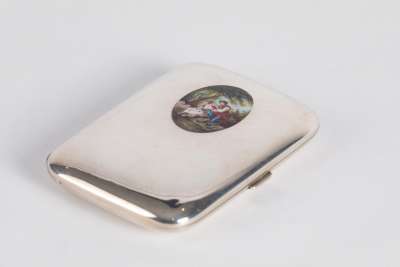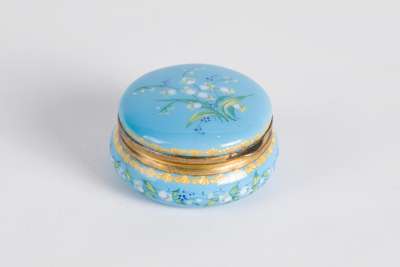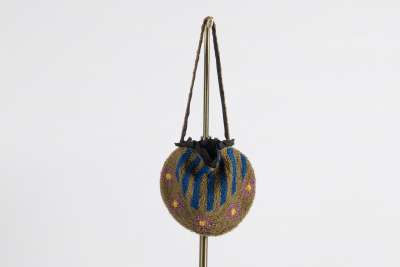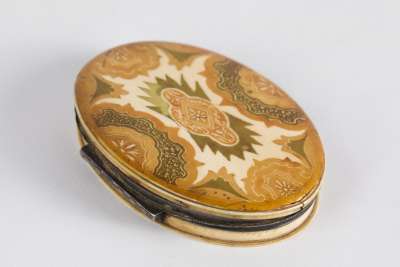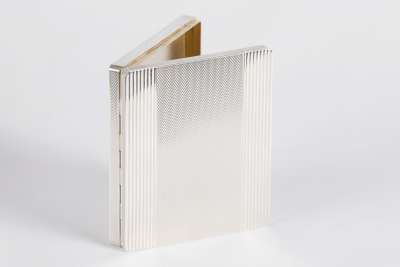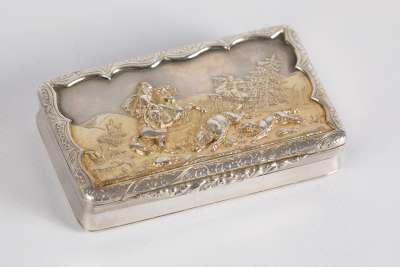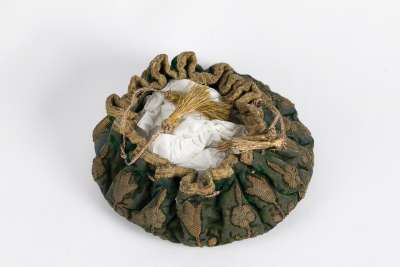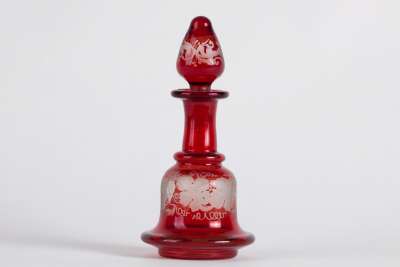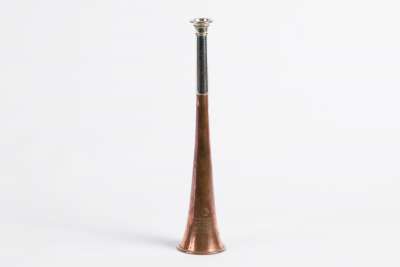This antique French posy holder, crafted circa 1860, showcases the delicate artistry of gilt metalwork. It features an intricately carved leaf and buckle pierced basket, creating an openwork pattern that envelops its cone-like structure. The design is further enhanced by a coiled tail with engraved detailing beneath the basket, offering an ornamental touch. The inclusion of a safety chain and a small ring highlights its functional elegance, typical of mid-19th-century France, and reflects the artistic sensibilities of the period. Circa: 1860
Condition Report
The posy holder is in good condition, with minimal wear visible on the gilt metal surface, consistent with its age. The intricate detailing of the pierced basket remains clear and well-defined, maintaining the piece's historical integrity. The safety chain and ring are intact, ensuring the accessory's functionality. Slight tarnishing is present on the metal, a common characteristic for items of this age, which adds to its authenticity. Importantly, there are no visible cracks or significant damage affecting its structural integrity, making it suitable for both display and use.
Dimensions
Weight: 0.002 g, Length: 9.5 cm, Basket Diameter: 3 cm at its widest point, Chain Length: 6 cm, Ring Diameter: approximately 1.5 cm.
A Victorian Era Accessory
Posy holders, often referred to as tussie-mussies or nosegay holders, were essential accessories during the Victorian era. They were designed to hold small bouquets of flowers, which were often used to convey messages through the "language of flowers." The attached chain allowed these holders to be securely attached to a belt or dress, enabling the wearer to keep the bouquet conveniently in place while freeing up their hands. This combination of aesthetic appeal and practicality made posy holders a popular and cherished accessory of the time.
Artistic Influence of the Second Empire Period
This posy holder embodies the artistic influences of the Second Empire period in France, which lasted from 1852 to 1870. This era was renowned for its eclectic designs that combined elements from Renaissance, Baroque, and Rococo styles. The luxurious ornamentation and intricate metalwork of this posy holder are reflective of the decorative sensibilities of the period, which paralleled the Victorian era in Britain. The piece reflects the period’s emphasis on elegance and intricate detailing, hallmarks of the Second Empire's aesthetic.
The Craft of Gilt Metal Artistry
Crafted from gilt metal, this posy holder showcases a technique that involves applying a thin layer of gold to a metal surface. This method was prevalent in the 19th century for creating decorative items with a luxurious appearance. The process required skilled craftsmanship to ensure the gold layer adhered evenly and accentuated the intricate details of the design. The seamless integration of the safety chain and the intricate carvings demonstrate the expertise involved in the creation of this posy holder, making it an exemplary piece of gilt metal artistry.
Crafted by Renowned French Artisans
While the specific maker of this posy holder remains unknown, the piece reflects the high standards of mid-19th-century French artisans. These craftsmen were celebrated for their ability to produce items that were both functional and decorative. The absence of a maker's mark suggests it was a bespoke piece, possibly crafted by a skilled artisan for a particular patron. The posy holder's quality and intricate design showcase the expertise of an experienced craftsman, contributing to its historical and artistic significance.
Collected by Fans of Victorian Era Artifacts
Posy holders were fashionable accessories and sentimental tokens during the Victorian era. Today, they are highly sought after by collectors and historians as unique artefacts of cultural history. This antique French posy holder represents more than just a decorative piece; it is a significant addition to any collection of Victorian-era artefacts. Collectors value these items for their historical resonance and the craftsmanship they embody, offering a glimpse into the past and the cultural practices of the time.




